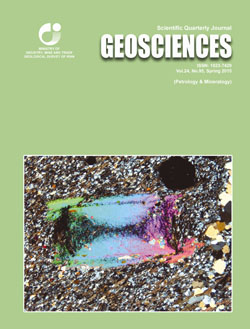Document Type : Original Research Paper
Authors
1 M.Sc. Student, Department of Geology, Tarbiat Modares University, Tehran, Iran
2 Associate Professor, Department of Geology, Tarbiat Modares University, Tehran, Iran
3 Assistant Professor, Department of Geology, Tarbiat Modares University, Tehran, Iran
Abstract
Tungsten (Cu-Au) mineralization of Southern Chah Palang (SCP) deposit, located in middle part of the Yazd block, occurred as vein-veinlet in normal fault zones, which cut the sandstones and shales of Early-Middle Jurassic Shemshak formation. Based on the mineral paragenesis and quartz type, color and texture, ore-bearing veins can be divided into 1) k-feldspar, apatite (I) bearing milky-white quartz veins, 2) white quartz veins contain apatite (II), 3) hematite- white quartz veins and 4) late carbonate veins. Wolframite is the main tungsten ore mineral in the SCP deposit, which occurred in type 1 vein. Wolframite crystals are riched in Fe and have ferberite composition. Scheelite, as next tungsten ore mineral in SCP deposit, formed in 2nd generation and show significant enrichment in As. Scheelite (I) coexist with Wolframite in type 1 veins, and Scheelite (II) replace wolframite in its fractures and rims, also with arsenic-bearing phases occurred in type 2 veins. Gold in SCP deposit occurred as coexist with and/or fine inclusions in Scheelite (II). Other ore minerals that formed in type 2 veins include base metals and Fe sulfides, cobaltite, niccolite, Cu-Ni-Fe sulfides and native bismuth. Type 3 and 4 veins are white quartz-hematite and barren carbonate veins.
δ18 O of ore-forming fluids, which milky-white and white quartz and wolframite formed from them are 7.91-8.61‰, 5.86-6.76‰ and 3.44-6.94‰ respectively. Based on the oxygen isotope studies, progressive mixing of original magmatic fluids with meteoric waters cause precipitation of metals in veins.
Keywords

